N-1wsletter #11: More powerful road disc brakes, a gravel suspension fork head-to-head, and… a bikepacking team?
It’s somehow been a very big week for new bicycle tech.
Featured in this week’s (extremely long!) tech round-up:
Bikes aren’t everything.
Wolf Tooth Components updates its very useful tire pressure calculator.
Formula makes a compelling pitch for more powerful road disc brakes.
Stinner Frameworks introduces the Refugio Select production gravel bike.
OneUp Components introduces its first clipless pedal.
New cranksets, chainrings, and cassettes from Classified.
Race Face adds shorter crankarms to the mix.
Old Man Mountain aims to win at camping.
Advanced driver assistance devices will help, but they still have a ways to go.
A neat widget that makes suspension setup a little bit easier.
Duplicate your fit with Dupli-Fit.
Cane Creek Invert SL vs. Fox 32 Factory Taper-Cast gravel suspension forks: Fight!
Get the sweat out of your sunglasses for cheap.
I’ve just wrapped up a short gravel ride as I write this. It being mid-January in Colorado, it was unsurprisingly chilly and a little windy, but also gloriously sunny with pleasantly dry dirt roads that I had almost entirely to myself. Being just my third ride since Christmas – outdoors or in – it was also very, very slow.
I remember a conversation I had with cycling living legend Ned Overend right around his 50th birthday. As conversations with Ned probably often go, the topic eventually came around to how he manages to be so ridiculously fast year after year after year. How fast, exactly? Ned will turn 70 this August, but he finished 15th out of 66 in the men’s pro field last year at the iconic Iron Horse Classic road race in his hometown of Durango, Colorado, ahead of a whole bunch of hotshots one-half to one-third (even one-quarter) his age.
The man is unquestionably a genetic anomaly, but one thing he told me has always stuck in my head even some two decades later: “It’s a lot easier to stay fit than to get fit.”
Those words play on repeat around this same time each year as I emerge from what has invariably been several weeks with pretty minimal riding, lots of food and cheer, and an acute lack of fitness. I used to feel guilty as I heard Ned’s sage advice in my head, slowly turning the pedals as I deliberately winched my way up climbs that I normally wouldn’t think twice about in July.
These days, though, not so much.
Interspersed with those three days of riding were six wonderful days of alpine skiing with my family. I switched from snowboarding a few years ago, partially so I could be a little less useless as our daughter was learning to ski, but also because I’d done it for ages, wasn’t getting any better, and had been thinking about switching for years, anyway. It hasn’t been the easiest thing to learn a totally new activity later in life, but it’s also been incredibly fun and rewarding.
I’ll still grab opportunities to head out for a ride when conditions allow (fat bikes FTW!). However, my more wholehearted embrace of a more winter-appropriate sport has not only proved good for me physically, but mentally as well. After all, it’s not always good to do the same thing day after day, month after month, year after year, and instead of feeling like I’m on autopilot as I sometimes do when riding, I’ve found myself feeling more present and focused – concentrating more, enjoying more, feeling more in general. And rather than be perpetually frustrated when it’s crummy outside that I couldn’t do what I ultimately wanted to do, I’ve learned to just enjoy the other things more instead.
Point being, Ned’s words still ring true, as always. However, there’s also something to be said for being perfectly ok with not caring all the time about being fit, either. The fitness will come, as it always does; I’m sure of it. But I’m guessing ten years from now, I’m going to remember a lot more vividly the giggles and howls the time my kid wanted to do nothing but steep tree runs all day long, her munching on the cold gummy bears I had to shove in her mouth because she didn’t want to take her mittens off, and the coziness of a warm fire after a long and joyful day on the mountain.
Life is good, but as we’re reminded all too often, it’s also full of far too many challenges. I’ll take the wins when I can – even when bikes aren’t involved.
In the news
It may be January, but there’s an awful lot of happenings in the bike world to share this week for whatever reason, so this’ll be a particularly news-heavy newsletter. Go grab yourself an extra-large mug of coffee this morning, and let’s dive right in:
Wolf Tooth Components revamps its tire pressure calculator
Wolf Tooth Components introduced its tire pressure calculator just this past September, and it’s already been updated with some new features as requested by users. The latest version (available either online or through an app) just launched this week with a new road tire category, additional width options for various knobbies (such as a 29x3” semi-fat size), a larger upper limit for rider weight, and even a drop-down for 26” wheels.
Speaking of tire pressure calculators in general, Wolf Tooth’s is worth a look because it covers the gamut of bike tire sizes from road racing all the way to fat biking, and also offers two versions. The so-called “basic” one is for riders that just want to consistently get in the ballpark with more general parameters such as rider weight, tire size, and surface conditions. The “advanced” one gets more detailed in terms of your equipment setup, but also compensates for changes in tire pressure related to ambient temperature – as in, how much your tire pressure will change if you inflate your tires inside a warm house but then head out into more wintertime conditions (spoiler: it’s probably more than you think). And in the event you’ve selected “hookless” for your rim type (because the calculator includes that option, too), it’ll also alert you if the ideal pressure for the specified conditions exceeds safety guidelines.
FYI, Wolf Tooth has openly stated that it advocates for lower tire pressures in general, so the suggested pressures may be a little softer than you’ve run in the past. That said, I’ve found it to be pretty close to spot-on for figures I’ve settled on over a period of trial and error, but as always, YMMV.
“The Wolf Tooth philosophy is based on the idea that lower pressures are better for performance,” reads a statement on Wolf Tooth’s web site. “Perhaps a better way to state it is ‘the lowest possible pressure consistent with terrain, riding style and equipment is better.’ It’s certainly possible to go too low and the difference between ‘just right’ and ‘too low’ can be small. The Bike Tire Pressure Calculator app powered by Wolf Tooth will find the ideal tire pressure that is at the intersection of fast, comfortable, and confident.”
Formula gets into the road hydraulic disc brake market
Italian brand Formula has been in the mountain bike hydraulic disc brake game since 1993 – even earlier than Hayes, who’s widely credited with bringing the technology to the mainstream masses. More than 30 years on, Formula is now getting into the road side of things.
The new Cura Road flat-mount brake caliper is designed to pair with existing Shimano and SRAM controls, and somewhat unusually for a road-focused performance product, weight isn’t the draw here. In fact, Formula’s new caliper actually seems to be a few grams heavier than stock. Instead, the company is approaching the road market with more of a mountain bike philosophy with claims that the Cura Road offers more power, better reliability, and a more consistent lever feel.
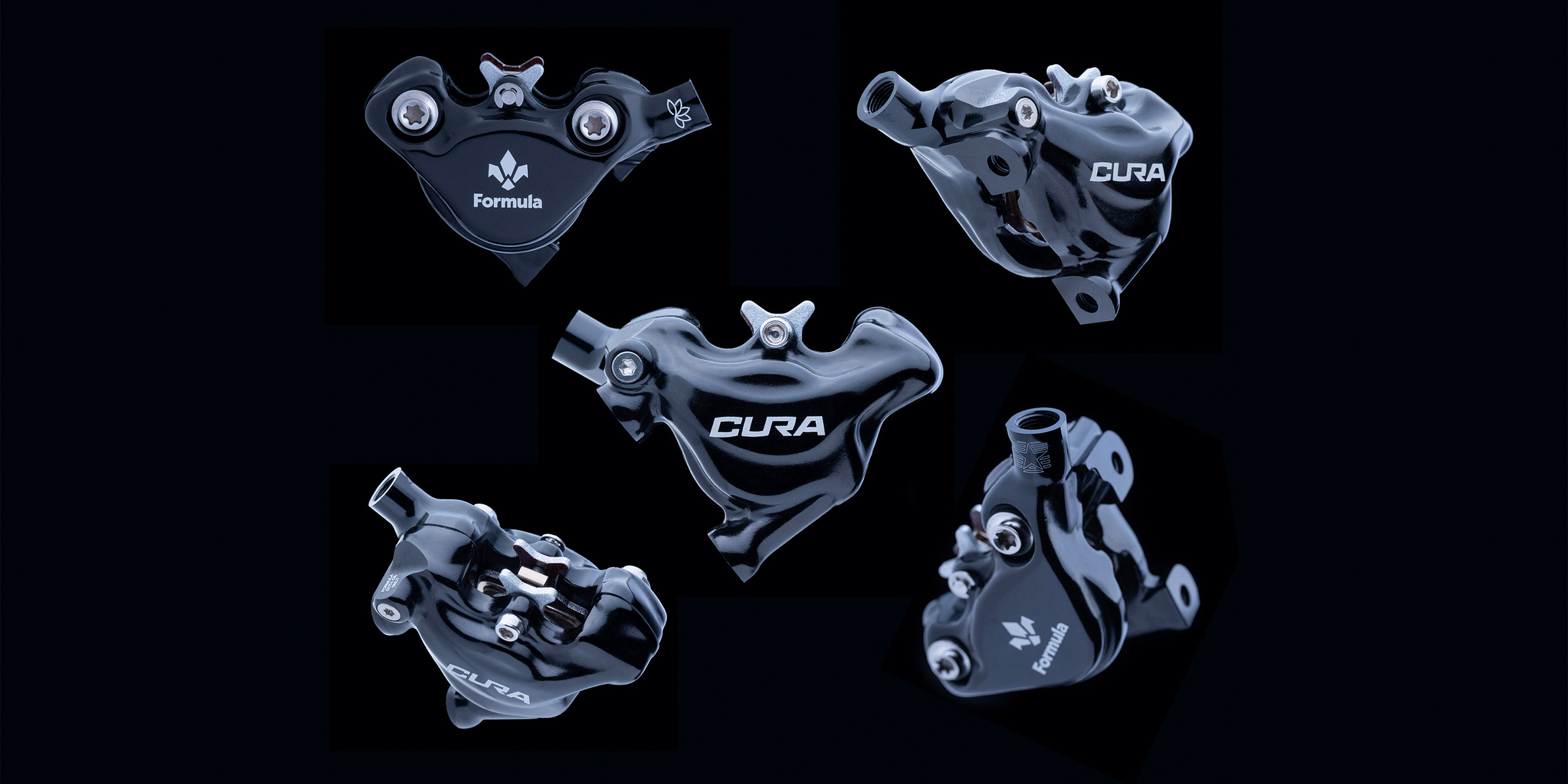
The two-piece forged aluminum design is offered in specific versions – 24 mm-diameter pistons and mineral oil-compatible seals for Shimano; 22 mm pistons and DOT-compatible seals for SRAM – both with titanium hardware and Formula’s existing Cura pads with aluminum backing plates.
Formula is also applying its comprehensive support policy to the Cura Road, which pledges, “parts, spares, and support for at least ten years.” Retail price is €115 / AU$190 per caliper (pricing for UK and EU markets is TBC).
Yet in a market where low weight and aerodynamic efficiency are valued seemingly above all else, how will Formula convince roadies that braking performance – something the MTB world has already prized for decades – should also be at the top of their minds, too?
“We know that in a discipline where weight, aero, and the prestige of components forged in the crucible of competition are top of most riders’ must-have attributes, braking has been an afterthought for many – heck, some are still resisting the move to disc brakes,” Formula’s head of communications, Sim Mainey, told me. “Will we be winning hearts and changing minds on that front? Probably not. But in pure performance terms the better your brakes, the faster you can ride. We think that matters, and so do some of the best riders.”
Digging further into that, Mainey said the new caliper came about directly from the requests of a certain top-tier team, who apparently wasn’t satisfied with its existing brakes’ “all or nothing” feel. To that end, the Cura Road supposedly offers a more linear performance that includes both the ability to lightly feather the brakes, but also a more predictable ramp-up in stopping power.
“For racers chasing those marginal gains, being able to out-brake a competitor gives them an edge. For casual riders, especially those who spend more time on the hoods, that means more stopping power with less effort.”
Who’s that team, you wonder? I’ve got a good idea, but we’re about to find out for sure in the coming weeks. In the meantime, I’ve got a set of calipers inbound so I’ll be able to see for myself, too. Stay tuned.
Stinner Frameworks adds more capable Refugio Select gravel bike to its production range
Santa Barbara, California-based custom builder Stinner Frameworks recently launched a more financially accessible production range, and while I found the first model in that category – the Carrizo Select – to be a pretty enticing all-road bike for steel aficionados, the limited tire clearance was just a little too… limiting.
Just this week, though, Stinner has now followed up on that initial offering with a gravel version called the Refugio Select.

Like with the Carrizo Select, Stinner TIG-welds the Refugio Select with Columbus steel tubing (a blend of Zona and Life, in this case) and its own CNC-machined dropouts, it’s offered in six fixed sizes and two fixed powdercoated colors, and it uses the same full-carbon fork as custom Refugios. And in a similarly distinct nod to serviceability and utility, it also features fully external cable routing (using a mix of bolt-on clips and zip-ties), a threaded bottom bracket shell, a 27.2 mm-diameter round seatpost with a traditional aluminum external clamp, and plenty of mounts.
But whereas the Carrizo Select’s tire clearance tops out at just 700x40 mm, the Refugio Select will accept 50s. And instead of using a more traditional gravel groupset with a single chainring and 10-44T cassette as is found on the Carrizo Select, Stinner has outfitted the single Refugio Select complete build with a SRAM Apex/Eagle GX Transmission “mullet” setup that features a much wider 10-52T cluster out back. Stinner has even added dedicated dynamo wire routing on the fork this time around.
The new Refugio Select should therefore be a lot more capable and versatile than the Carrizo Select, but the pricing is just as reasonable at US$1,700 for the frameset and US$4,000 for the complete bike.
Good stuff. Maybe do the Tunnel hardtail MTB next?
OneUp Components going clipless
OneUp Components’ aluminum and composite flat pedals have been wildly popular for their mix of outstanding performance and highly accessible pricing, and the company is now hoping for similar success with its first-ever clipless model called the, uh, Clip Pedal (I’ll explain in a bit).
Just as with its flat pedals, OneUp has built its new Clip Pedal with an unusually thin body to reduce the chance of rock strikes, but yet it still boasts a generous “DH-sized” aluminum platform for good foot support with the option for four replaceable pins per side for additional grip.
Support is a core focus for the Clip Pedal, in fact. OneUp says the new pedals are SPD-compatible (meaning actual Shimano cleats will work just fine), but the stainless steel binding mechanism is designed to offer a more precise fit with your shoe to prevent any out-of-plane rocking – so much so that the stock OneUp cleats include shims so you can get the fit just right.
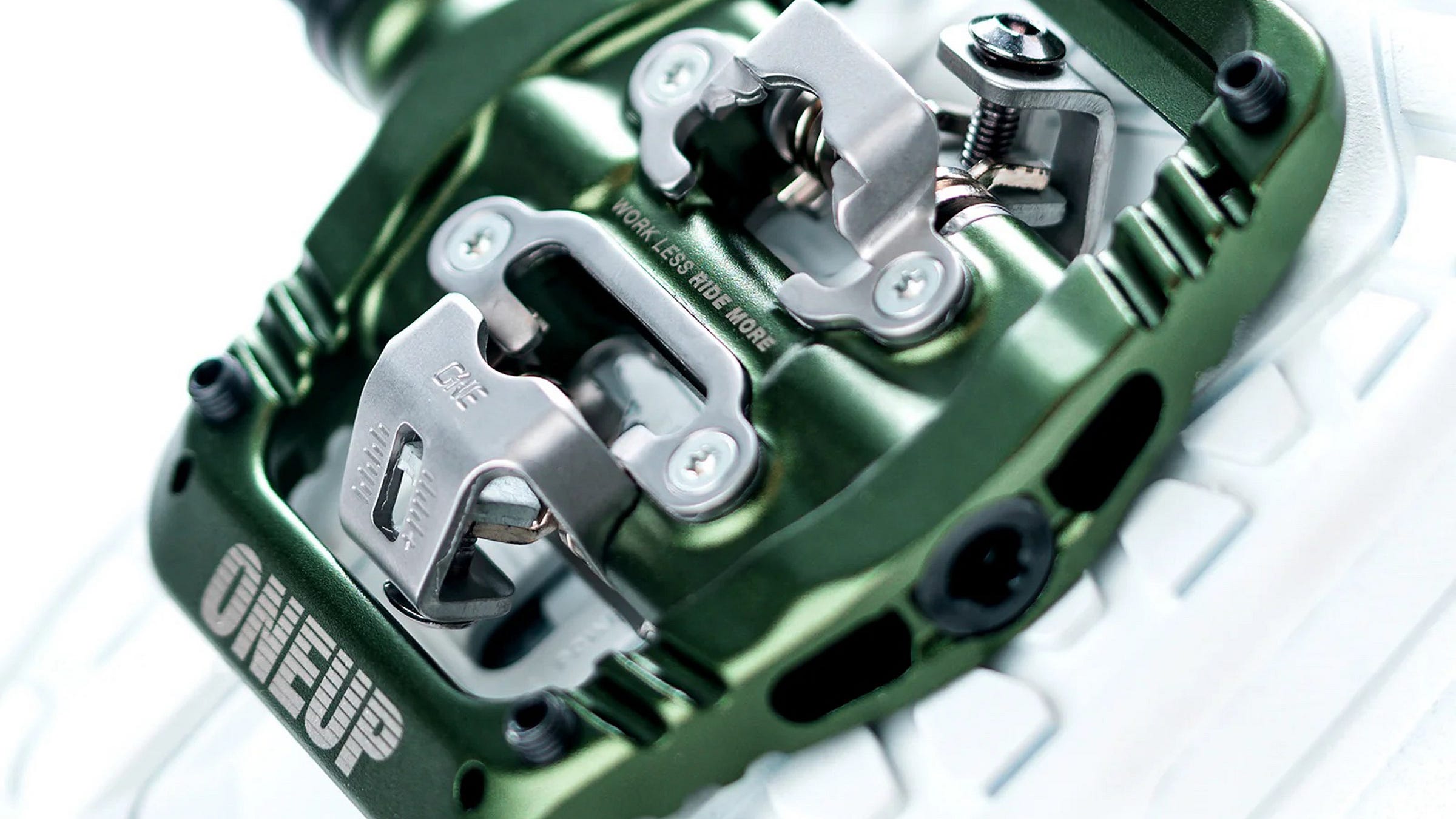
One potential compromise to achieve that thinness is durability. Each Clip Pedal axle assembly boasts three cartridge bearings on the outboard side, but an Igus solid composite bushing on the inboard side. That said, OneUp has long used a similar setup on its stalwart composite flat pedals for years without any major issues so take that as you will.
Claimed weight is 410 g – just a smidge heavier than a set of Shimano XTR Trail pedals – and OneUp is offering the Clip Pedals in eight different colors. As is typical for OneUp, retail price is impressively reasonable at US$160. I’ve purchased a whole bunch of OneUp stuff for myself over the years and honestly been very pleased with every bit of it, so I’m looking forward to taking delivery of a set of these Clip Pedals for a proper review.
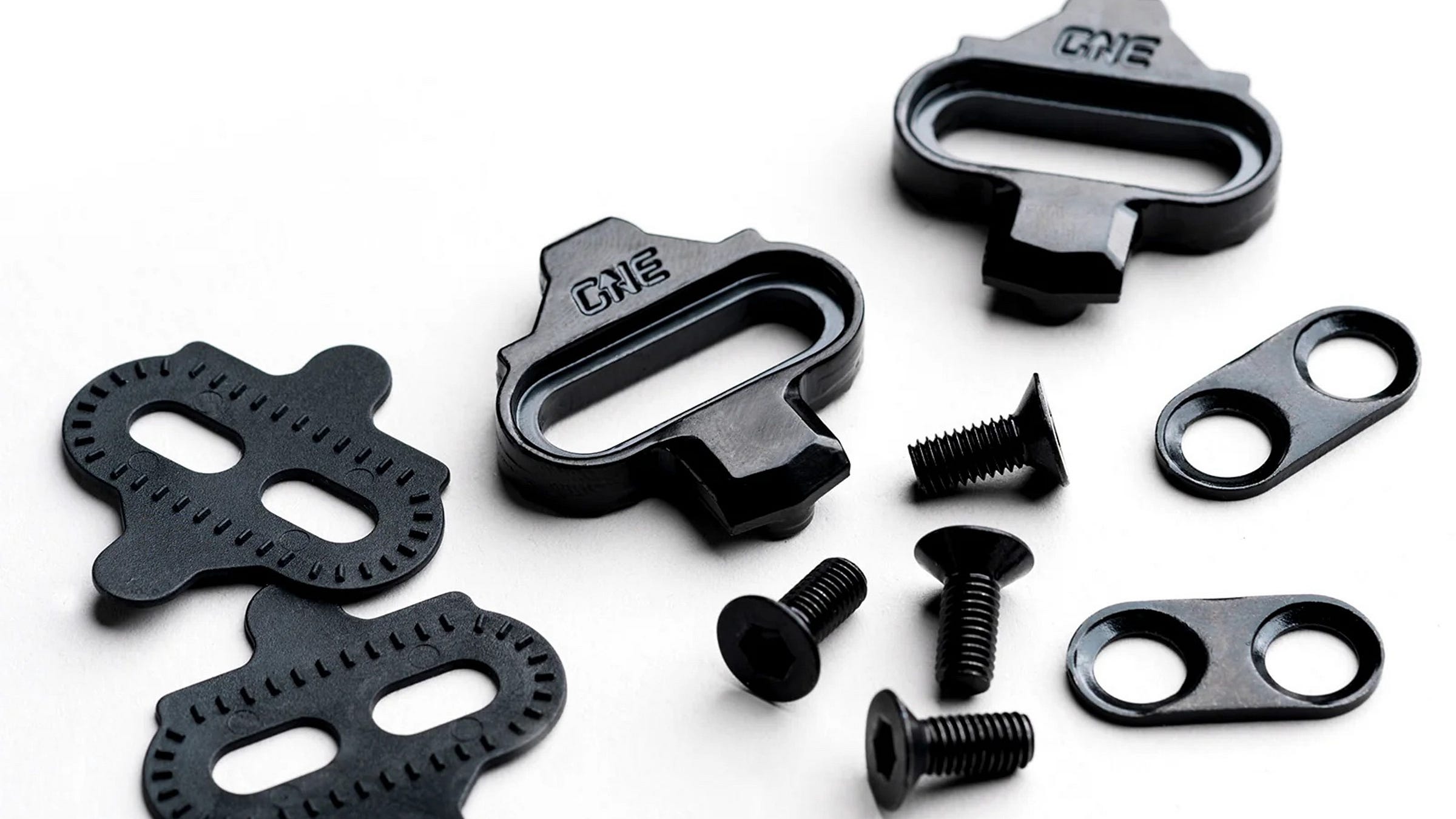
Oh, and about the nomenclature: These days, people often refer to mountain bike pedals you physically attach to as “clip” pedals since you “clip into” them. However, the origins of the pedal concept date back decades to when it was commonplace to have goofy plastic baskets and straps around your feet to help hold them in place on the pedal platforms. Those baskets were officially referred to as toe clips, and so when Shimano’s original M737 pedal hit the market in 1990, they were therefore referred to as “clipless” pedals.
Kids these days.
Classified expands its range of drivetrain components
Remember that Belgian company Classified and its novel Powershift two-speed rear hub transmission? Well, the company is continuing its forward march, now with a new crankset, wider-range cassette options, and new extra-large chainring sizes, all with the goal of providing Powershift hub users with “even greater compatibility and integration.”
The new 1x Aero Crankset is built with hollow carbon fiber arms that feature a “cutting-edge aerodynamic profile.” The non-drive arm is attached to a 30 mm-diameter aluminum spindle and incorporates an integrated threaded bearing preload collar, and Classified is offering that spindle in two lengths for road and gravel applications (with 146 and 154 mm Q-factors, respectively).
Perhaps more significant than the crankset is Classified’s new 1x chainrings. These are offered in particularly large sizes that are better suited to Classified two-speed hub drivetrains – 46 and 48T for gravel, and 50, 52, and 54T for road – and they use the same spline pattern as Race Face and Easton for a bit of potential cross-compatibility. They’re also quite light for the size, with the 50T one coming in at 182 g.
“It was a big and fun project with lots of FEA,” said Brendan Moore, co-owner and VP of Wolf Tooth Components, who manufactures the rings for Classified. “We actually got the weight lighter than we could have with our traditional five-spoke design.”
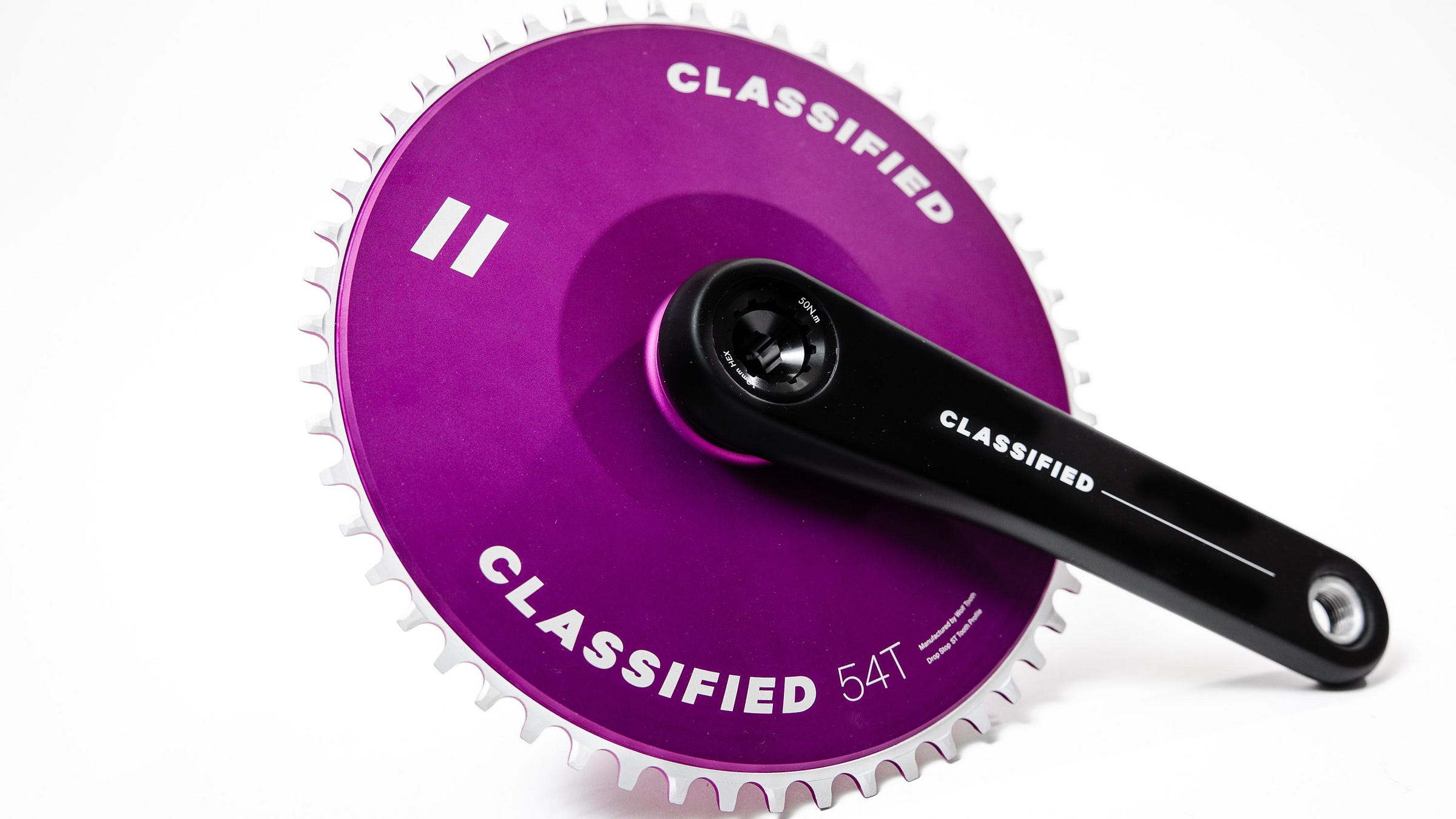
Claimed weight for the complete crankset is just 650 g with a 50T chainring, and retail price for the set is €450 (without bottom bracket).
Capping off the assortment of new bits are four cassette options: 10-36T, 10-40T, and 10-40T T-Type for 12-speed drivetrains, and a 10-40T 13-speed cassette for SRAM’s latest Red AXS XPLR system. Combined with the Powershift two-speed hub, Classified says the new cassettes offer a much broader selection of options to better suit a rider’s particular needs, with up to 580% of total range – substantially wider than any conventional 1x drivetrain currently on the market.
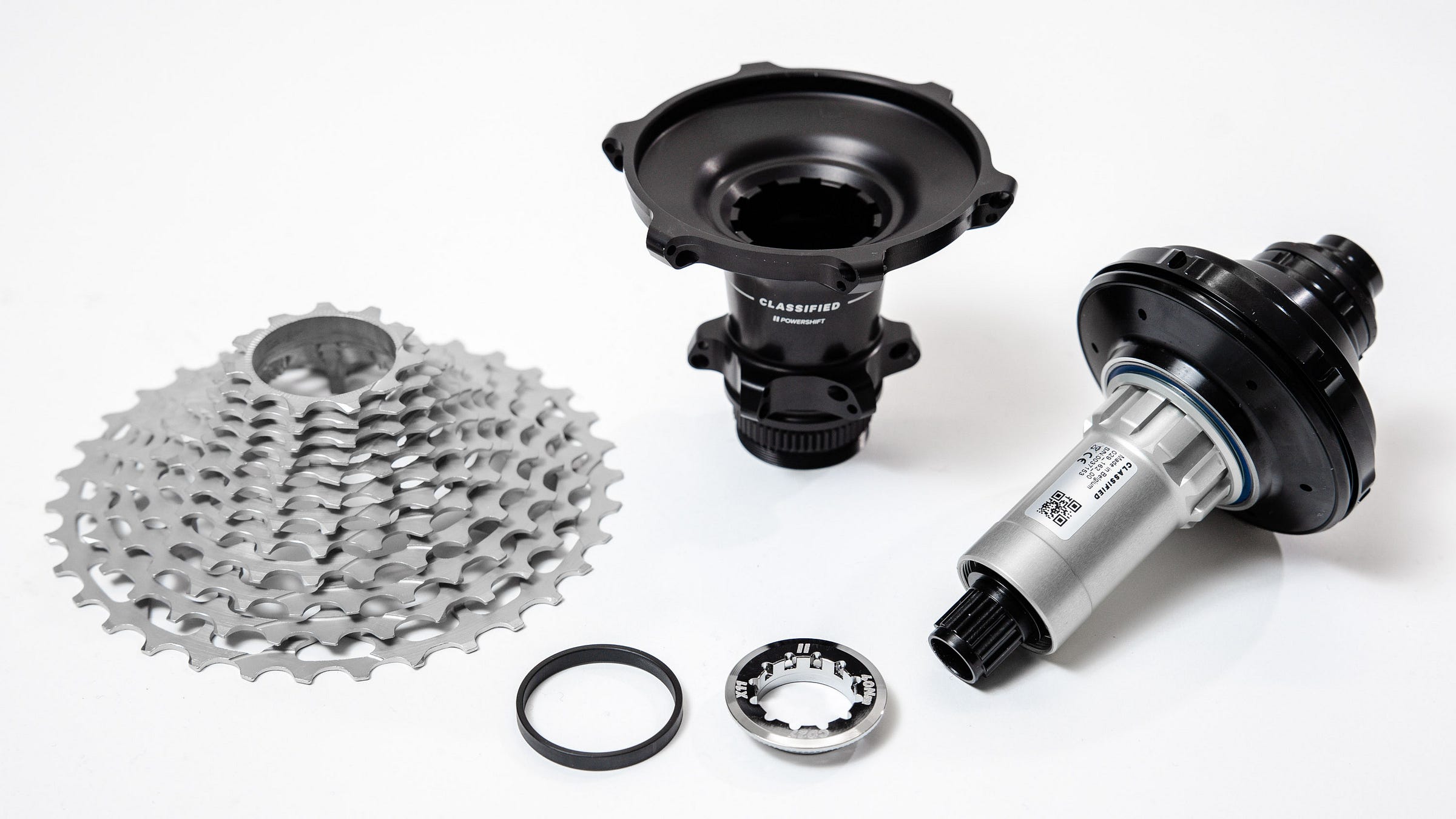
The cassettes are light, too, with one-piece machined steel construction and claimed weights from just 243 to 279 g. Sorry, I don’t have any official retail prices on the new sizes yet, but based on existing offerings, they should be less than US$300 / £200 / €250 / AU$400.
All of this stuff certainly helps to fill out the Classified ecosystem, but there’s still no official word on when the company will debut its much-anticipated brake/shift levers with integrated controls. That’s when things will get really interesting.
Race Face goes stubby with new crankarm length options
The move toward shorter crankarms is only recently taking hold in the road and gravel space, but – as is often the case – that trend already started years ago for the mountain bike crowd, though largely as a way to reduce pedal strikes, not for biomechanical reasons.
Be that as it may, Race Face has just announced the addition of 160 mm-long arms for its popular Turbine forged aluminum and Era hollow carbon fiber mountain bike cranksets, as well as the Era e-MTB arms – all of which were already offered in 165 mm. Those cranks will also be covered under the same lifetime warranty as before, too (“Crashes included”).
Is this big news? Nope. But still pretty cool to see nonetheless.
Old Man Mountain debuts a new bikepacking… team?
A friend of mine once sung the carefree praises of outdoor recreation with the catchphrase, “No one wins at camping” – an ode to the idea that enjoying the outdoors shouldn’t be at all competitive.
Apparently the folks at Old Man Mountain didn’t get the memo, but don’t worry, it’s not quite what you think.
The new Experimental Bikepacking Team is a collaboration with Silca and The Robert Axle Project, and features a international roster of five athletes: Hannah Simon, Eric House, Paola Berber, Stephanie Hall, and Mateo Paez. Despite being labeled as a “team”, ending up on podiums isn’t exactly the primary goal here.
“Bikepacking races celebrate solo efforts, independence, and solitude,” read the press release from Old Man Mountain, “but they also want to see what happens when a team prepares and grows together, strengthening their abilities to go do it alone when the grand departure arrives.”
“The idea is very fitting to the name; it is an experiment to see what a team could look like in ultra racing. The events are based on solo efforts so the team is more about the preparation for these events. We are bringing the riders together to share knowledge from past experiences riding these races, nutrition strategies, gear and training strategies, etc.
Old Man Mountain marketing director Eric Fenner says there’s an R&D aspect to the team as well.
“Absolutely a part of the motivation is to use the team to help develop new equipment,” he told me. “These events represent some of the harshest conditions possible for gear and the requirements these racers have is highly nuanced. It may not be easy but if we can please as picky a crowd as ultra racers, the products should go over great with your more casual bikepacker.
“We have new bags, multiple racks, and more in the works. If people keep a laser eye on our riders' kits they will be sure to see some as the year continues. We have new products from Robert Axle Project as well. And we will be putting Silca's endurance chip wax additives and lubes to the test.”
Maybe someone wins at camping after all.
Automatic emergency braking is a positive step for rider safety, but still imperfect
US national team member Magnus White was tragically killed by a presumably inattentive driver on July 29, 2023, just minutes away from his home in Boulder, Colorado. He was only 17 years old, and was slated to represent his country just days later at the UCI world championships in Ireland. As the parent of an 11-year-old, I can barely even type those words without tearing up a little.
Magnus’s parents have since established The White Line, a non-profit organization dedicated toward improving the safety of vulnerable road users.
“By 2035, we envision a fundamental transformation of our driving culture where careless and reckless behavior becomes unacceptable,” reads a statement on the organization’s web site. “This transformation begins today, powered by immediate action to change driver behavior rather than waiting for infrastructure improvements. Within 10 years, we hope to make roads so safe for everyone that The White Line can close its doors, knowing we've honored Magnus White's legacy.”
Part of that work is the Magnus White Safety Act of 2024, a bill introduced by Colorado representative Joe Neguse to the 118th US Congress proposing that auto manufacturers be required to incorporate automatic emergency braking systems, “that can detect cyclists, pedestrians, and other vulnerable road users across all conditions.”
The technology is already featured in many modern automobiles, but often only in higher-end vehicles or as an available option at additional charge. The White Line contends that requiring AEB technology in all new vehicles would prevent unnecessary deaths caused by situations such as inattentive driving, and given the circumstances on that day in July – a stretch of road with massive shoulders, excellent sightlines, and good weather – one can’t help but think AEB could have prevented Magnus White’s death on that bright summer morning.
A recent report from the US-based Insurance Institute for Highway Safety (IIHS) suggests that even if such a bill were to become law, the technology isn’t exactly foolproof. While the IIHS says AEB systems “reduce the rate of pedestrian crashes of all severities by 27%,” that figure becomes “negligible” at night. Even worse, the IIHS study found that some tested systems were particularly confused when mannequins were wearing bright or reflective clothing, and while the study was conducted in the context of emergency roadside workers who typically don those types of garments for safety, many cyclists and runners do the same in low-light conditions.
“The lapse is a concern, considering the number of roadway workers and emergency personnel who use similar garments to mitigate risk when they’re working on the road,” the study concluded. “Further research is needed to determine how crash avoidance systems respond to the specific safety equipment used by such workers.”
That’s not at all to say that efforts such as the Magnus White Safety Act of 2024 aren’t worthwhile; anything but, in fact. Nevertheless, it seems technology alone isn’t going to save us.
TL;DR review: Crest Tool Suspension Sag Ruler
Measuring sag on mountain bike (and now gravel!) suspension forks and rear shocks has always been a bit of a pain in the butt – not so much in terms of the actual process, but rather figuring out how much sag you should run, and how it should be calculated.
Determining the ideal target amount of sag isn’t always an exact science. I usually start with brand recommendations – usually somewhere between 20-30% of the total stroke – and then adjust from there based on feel. Translating that percentage into a physical measurement is more straightforward, though it involves a bit of math (27% of 55 mm? Well that’s 14.85 mm, obviously).
A neat little 3D-printed widget from Crest Tool in Salt Lake City, UT, makes part of the process a lot easier.
The Suspension Sag Ruler is just what it says on the tin, with a 75 mm ruler on one edge (for suspension forks) and a 35 mm one on the opposite edge (for rear shocks). It’s far more compact and fits into tighter spaces than anything off-the-shelf that you’d use, and the clever design includes raised ends that leave room for the indicator o-ring.
But the best part about the Suspension Sag Ruler is the sticker on the back (seriously). Crest Tool founder EJ Dorrian has gone ahead and calculated the most common sag figures for you and put them right on the tool itself. Want to run 25% of sag on your 65 mm-stroke rear shock? You’re looking for 16 mm. 20% sag on your 120 mm-travel RockShox SID? 24 mm. 30% of sag on your 200 mm-travel Fox 40? 60 mm. Done.
I’m a big fan of simple tools that save time, and this one most definitely fits into that category. The fact that it’s only US$7 is icing on the cake.
Incoming
Arch Design Works Dupli-Fit measurement jig
Speaking of measuring, one of the particular quirks about my line of work is the frequent need to replicate my fit on a different bike: saddle height and setback, bar height and reach, and so on. I’ve historically used a laser level (with both vertical and horizontal) and tape measure in my garage for much of that work, but the Dupli-Fit widget from inventor Dave Archer promises to make the process a lot faster.
Whereas most measurement jigs are based on Cartesian coordinates (using a familiar X-Y layout of horizontal and vertical dimensions), Dupli-Fit is intriguing in that it’s built around a polar coordinate system where the relation of two points in space is defined by angle and distance.
Setting up a bike with Dupli-Fit requires two main steps.
After anchoring and leveling the Dupli-Fit base on the saddle at the 80 mm width point, a cone at the end of the rotating and extending measurement rod then locates the center of the bottom bracket spindle. Once the hard points are set, you can then read the linear distance and relative angle off the base.
From there, you can then rotate the measurement rod upward and repeat the process for the bar measurement, only this time referencing the center of the tops (or whatever point you decide, depending on the shape of the bars).
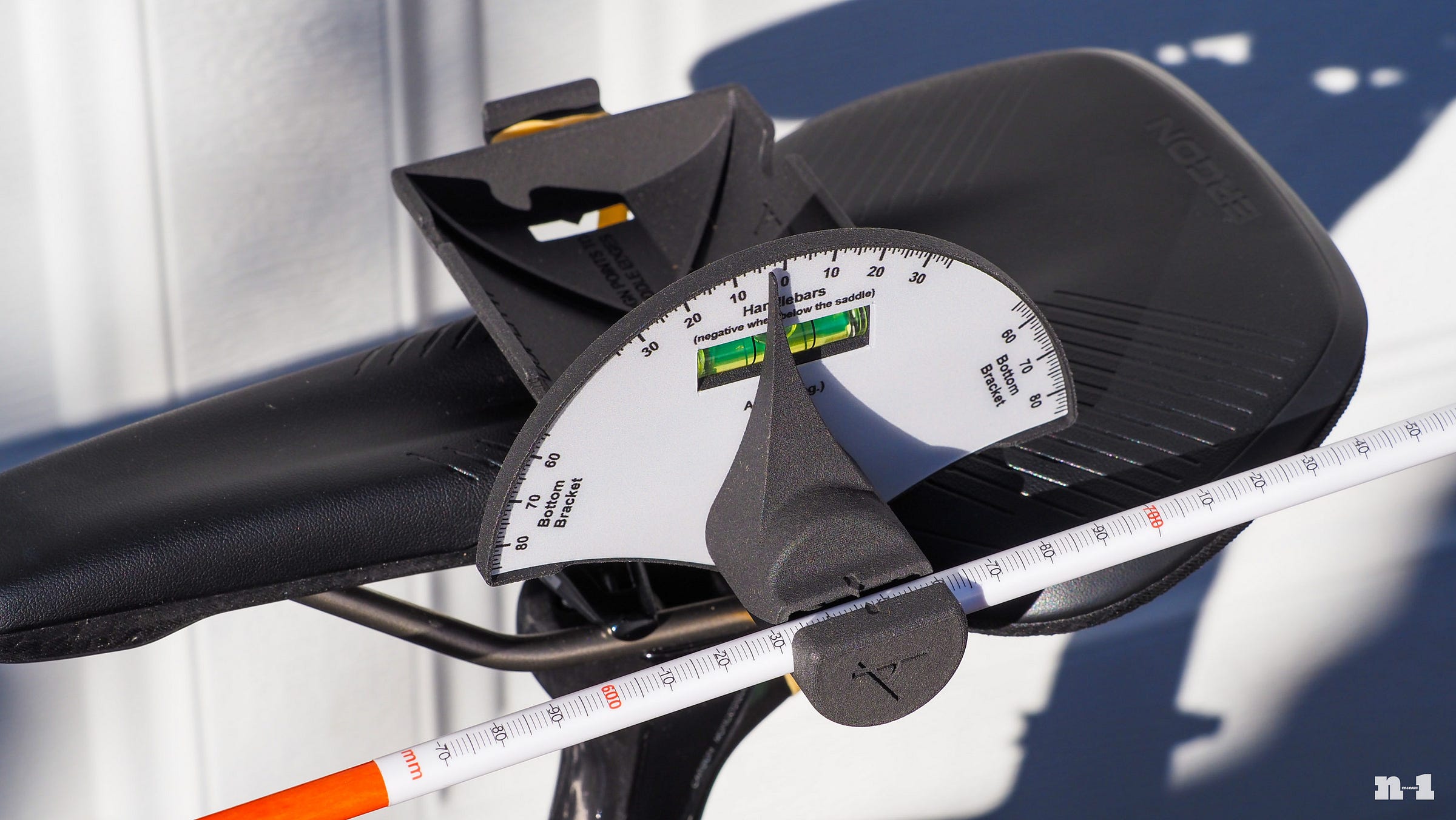
The simplicity and compactness of the Dupli-Fit jig is appealing, as is its relatively accessible cost (US$89). However, I already have some questions and concerns.
Setting the base requires visually gauging where the saddle is 80 mm-wide using two pointed indicators, rather than a pair of extended arms that would physically bracket that point for more consistency. It’s held in place with just a rubber band instead of something more robust, so the base is prone to inadvertent movement. The angle markings also only go down to 1° increments, so getting very precise measurements – like, single or even just single-digit millimeters – will be tricky.
Perhaps more fundamentally, Dupli-Fit’s use of polar coordinates will make it challenging if you’re working off of a fit sheet built on a Cartesian system. For example, how would you translate “65 mm of saddle setback” or “84 mm of bar drop” to polar coordinates? It’s certainly possible with a little bit of trigonometry, but that complicates something that’s otherwise designed to be quick and easy to use.
I’ll play around with the Dupli-Fit more in the coming weeks, but my initial impression is it’ll be more useful for duplicating the fit between two bikes – hence the name, I guess – than setting up a new bike based on conventional measurements from a fitter.
Stay tuned.
Cane Creek Invert SL gravel suspension fork
I was fortunate enough to spend some time on an early-production Cane Creek Invert CS gravel suspension fork when it was first introduced last year, and while I found an impressive level of performance from its modest 40 mm of travel, crown-mounted manual lockout, and 1.1 kg claimed weight, I’ve been curious ever since then about the more pared-down Invert SL.
That model cuts the travel down even further – just 30 mm in total – and also does away with the lockout. But as a result, it also brings the actual weight down to just 1,037 g (with axle and uncut steerer), and bucking the industry trend of charging more for less, the Invert SL is also a bit less expensive than the more fully featured Invert CS at US$1,100 / £1,100 / €1,200 / AU$1,848.
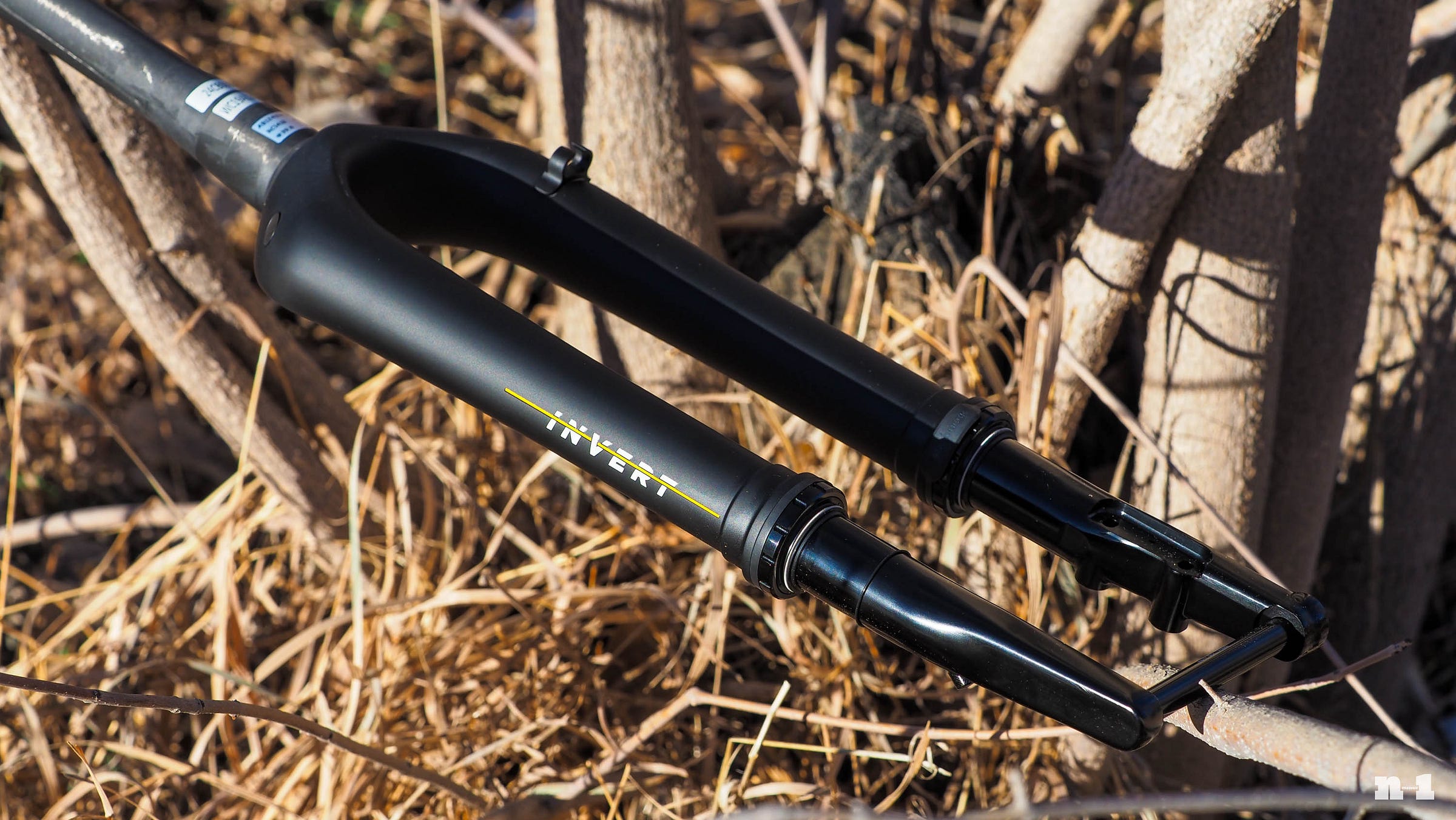
I’ve just received a test sample and I’m looking forward to answering a whole bunch of questions in my head. Will I miss having a manual lockout or hydraulic damping (neither of the Inverts have any)? Is 30 mm enough to justify the additional weight and cost compared to either a rigid carbon fork or even a suspension stem? How much maintenance is required to keep it running smoothly? How will my Santa Cruz Stigmata handle with a fork that’s just a smidgeon shorter than what it’s designed for?
Fingers crossed that this favorable testing weather carries on for a bit longer.
Fox 32 Factory Taper-Cast gravel suspension fork
Do I sense a head-to-head coming on? Maybe – but maybe not. The Fox 32 Factory Taper-Cast I also recently received may be a gravel-focused suspension fork like the Cane Creek Invert SL, but it takes a very different approach. For one, it uses a conventional telescoping design instead of the Invert’s, uh, inverted layout, albeit one with an unusual reverse arch that sits behind the stanchions instead of in front.
The Fox fork’s 40 mm of travel also makes it more comparable to the Invert CS instead of the SL, but the biggest difference is that it includes a proper hydraulic damper – in this case, Fox’s latest Grip SL unit with a three-position crown-mounted compression damper adjuster, better small-bump sensitivity, and a dramatically pared-down layout that lops off about 60 g, for an actual grand total of 1,275 g (with axle and uncut steerer).
I’ve already spent heaps of time on the original 32 TC so I’m curious to see how big a difference the updated damper makes (if any), as well as how much of an advantage having a damper offers compared to the wholly undamped Invert SL (if any). Retail price is US$950 / £TBC / €1,260 / AU$1,700.
Sheesh. I need one of those duplicator things from Calvin and Hobbes – or at least the days to get a lot longer very quickly.
ICYMI
While I’m on the theme of measuring things, ever get frustrated trying to get your road/gravel levers perfectly even with each other? Sure, there are specific tools available to do that job, but it turns out all you need is a straight piece of metal, a couple of rubber bands, and a good eyeball.
Find out how here.
Hack of the week/tech tip
I think most people reading this will have experienced at some point sweat dripping down into your sunglass lenses. It’s annoying for sure, but also arguably a safety issue since it hampers your vision. Some eyewear brands combat this by incorporating hydrophobic surface treatments on to their lenses. This helps sweat (as well as rain and road spray) more readily bead up and roll off to leave a clearer lens behind, and they generally work ok – better than nothing at all, at least.
But what do you do if your sunnies don’t have that feature from the manufacturer? I’ve seen a handful of aftermarket treatments that promise to deliver the same hydrophobic performance as factory setups with a simple spray-on or wipe-on application, but they invariably offer tiny quantities of fluid with less-than-palatable asking prices. As it turns out, there’s another solution that’s not only way less expensive, but might even be available at your local auto parts store.
I’ve used Rain-X windshield treatments for almost as long as I’ve had a driver’s license, and the way it makes rain bead up and roll off of the glass has to be experienced to be believed. In many cases, it works so well that I don’t even bother to use windshield wipers; it really is that good. The original formula unfortunately isn’t really safe for plastics, but Rain-X introduced a specific product a few years ago. It’s primarily billed for use on “motorcycle windscreens, goggles, visors, and boat windshields,” but seeing as how it’s explicitly approved for use on stuff like polycarbonates and acrylics, that also means it’s safe to use on nearly all cycling-specific sunglasses, too.
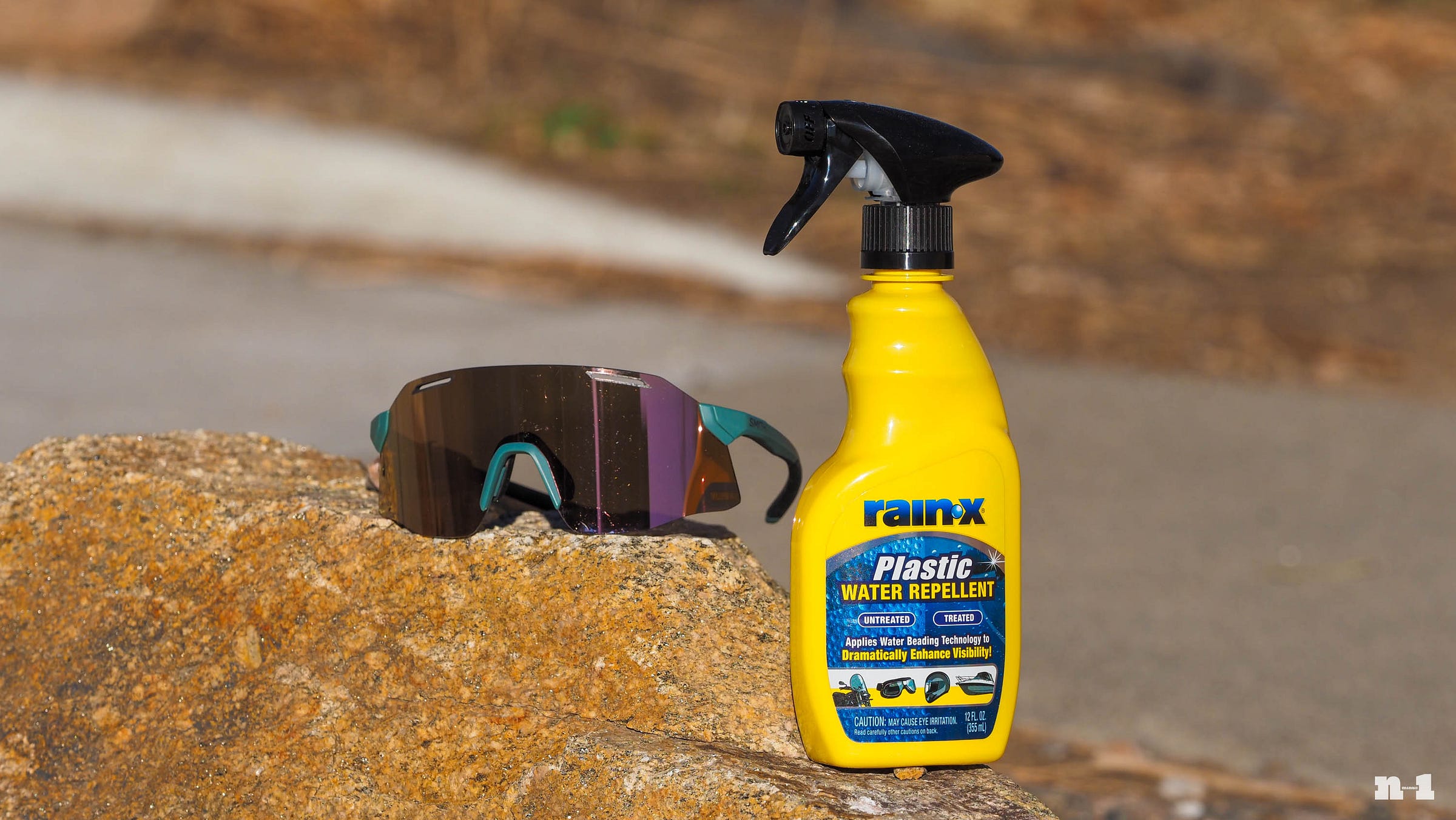
I bought a spray bottle a couple of weeks ago and have treated several pairs of sunnies already – even applying it to just one half of some lenses so I could directly compare results. And you know what? It works great so far. It’s quick and easy to apply, water indeed rolls off just as you’d hope, and I haven’t detected any damage to factory coatings like mirrors and anti-glare.
Now, keep in mind that sweat is a little trickier in that it not only adds different salts to the mix, but there’s also various oils mixed in, along with perhaps sunscreen and road grime. To be clear, no hydrophobic lens surface treatment works as well on all of that as it does on straight water, and it’s also worth pointing out that hydrophobic coatings generally work better on larger bits of water than tiny droplets.
However, it’s certainly better than no treatment at all, and for about US$7, you get a bottle that’s not only big enough for the whole family, but perhaps your whole riding club, too.
Recipe of the week
I mentioned a few newsletters ago that I’d be sharing some recipes I’ve been playing with lately, and I came across a real banger last week: sourdough chocolate chip cookies. These aren’t all that different from classic chocolate chip cookies, except you’re adding a hint of tanginess from the inclusion of sourdough starter discard.
This recipe made more cookies than I’d expected (almost twice as many as is stated in the recipe, in fact, so adjust accordingly), but given how tasty they were, that ended up being a blessing in disguise. These are super easy to put together if you have a stand mixer and pretty hard to screw up if you follow the directions. Just make sure you don’t ignore the final step before baking where you chill the dough for a couple of hours (unless you’re one of those weirdos that like really flat cookies).
Anyway, with that all said, enjoy!
Whew, that was a big one! Nearly 6,000 words this time around – eek. Thanks as always for reading – and subscribing! – and we’ll see you all after the weekend. Slated for early next week is a handy workshop piece on SRAM DUB cranksets that could very well save your knuckles (and your sanity). It’ll be a paid post (as in, only available in full to paid subscribers, not paid for by SRAM or anyone else), but if you’ve ever cursed at your DUB-equipped bike in your garage, I promise it’ll be worth your while.
Are you already a subscriber to n-1? Tell your friends! You’re not a subscriber? Then what are you waiting for?
Hit the button. You know you want to. And let’s not forget that this newsletter – as are all n-1 newsletters – is 100% free for everyone.





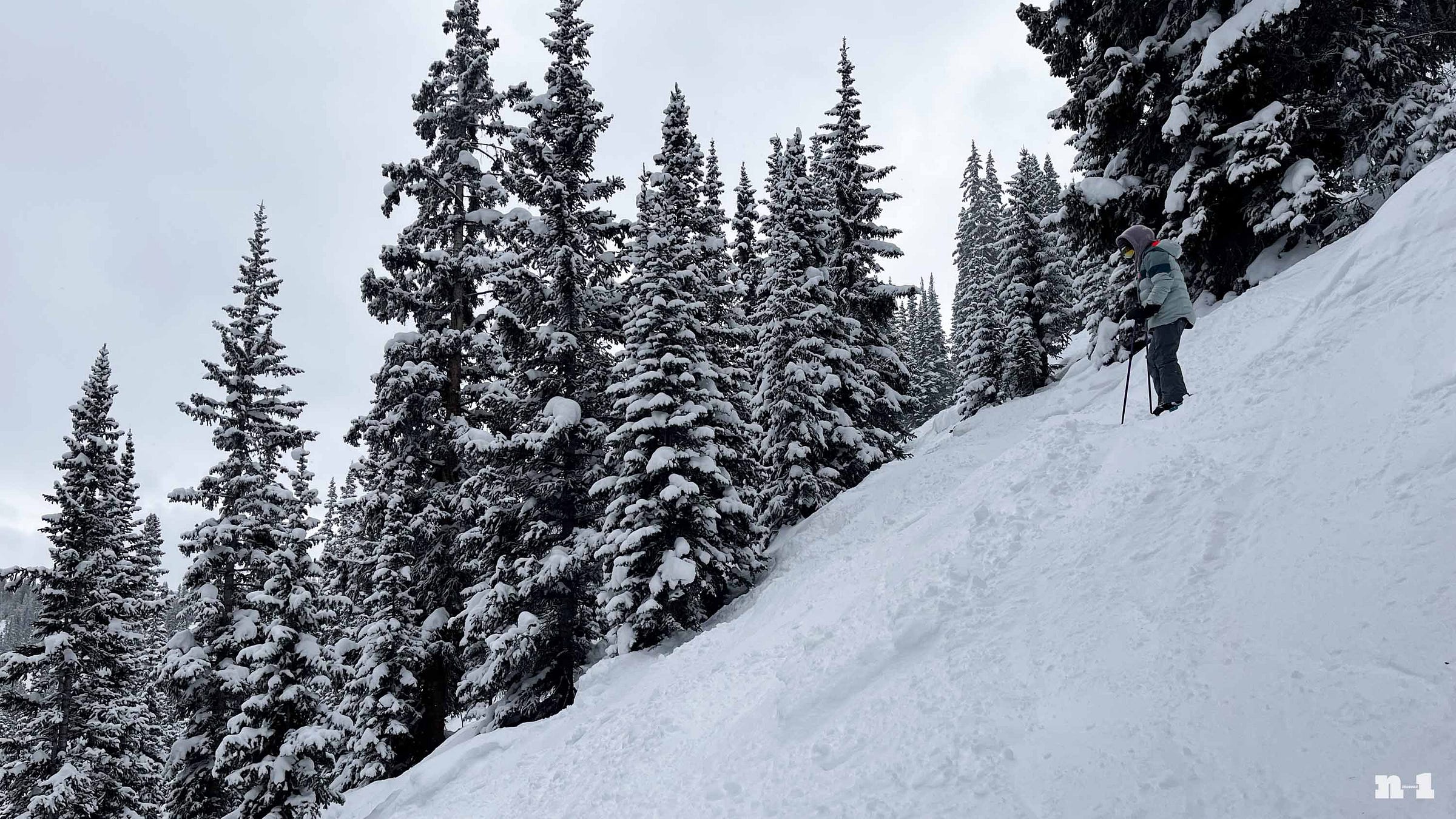
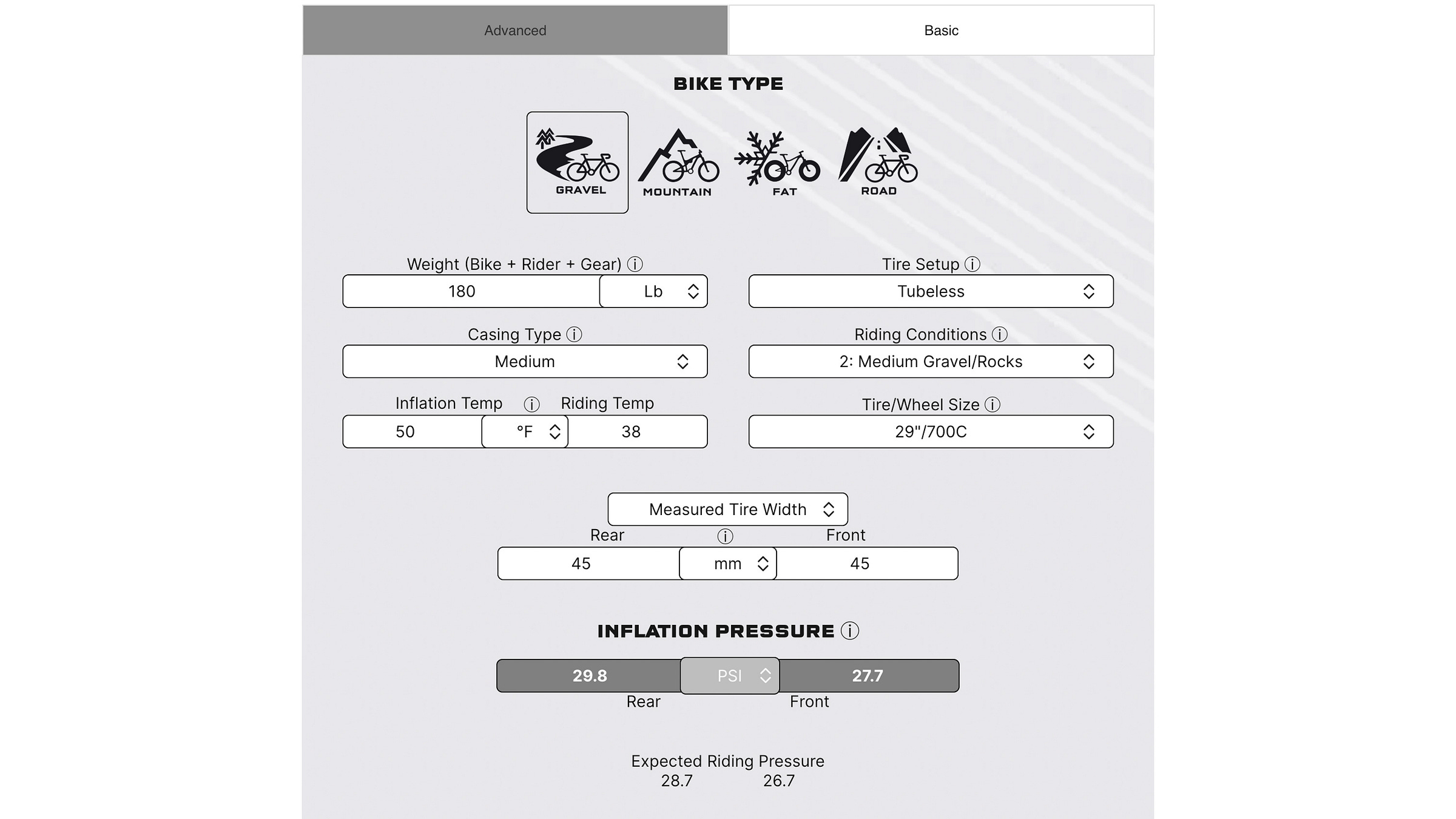

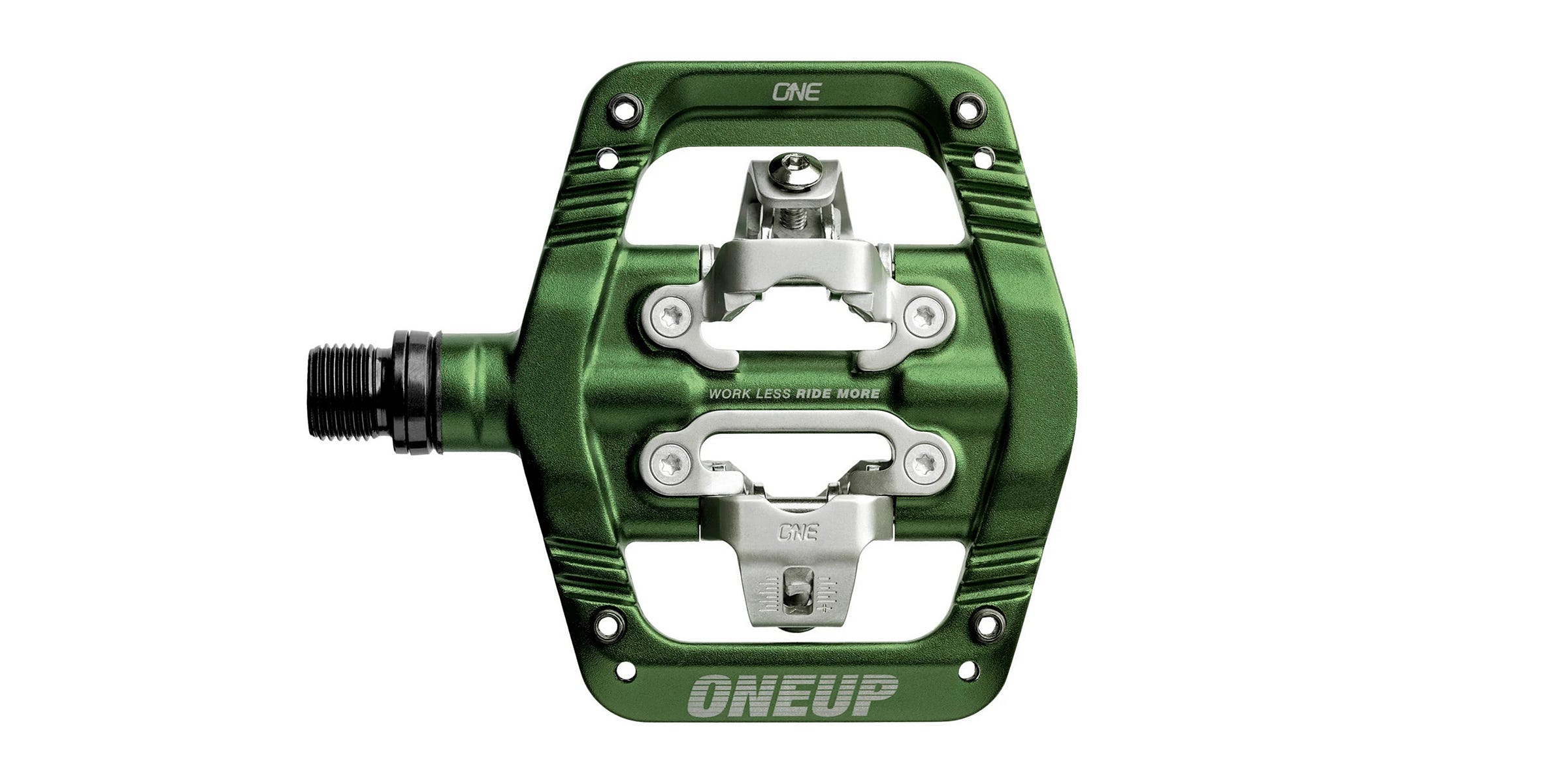
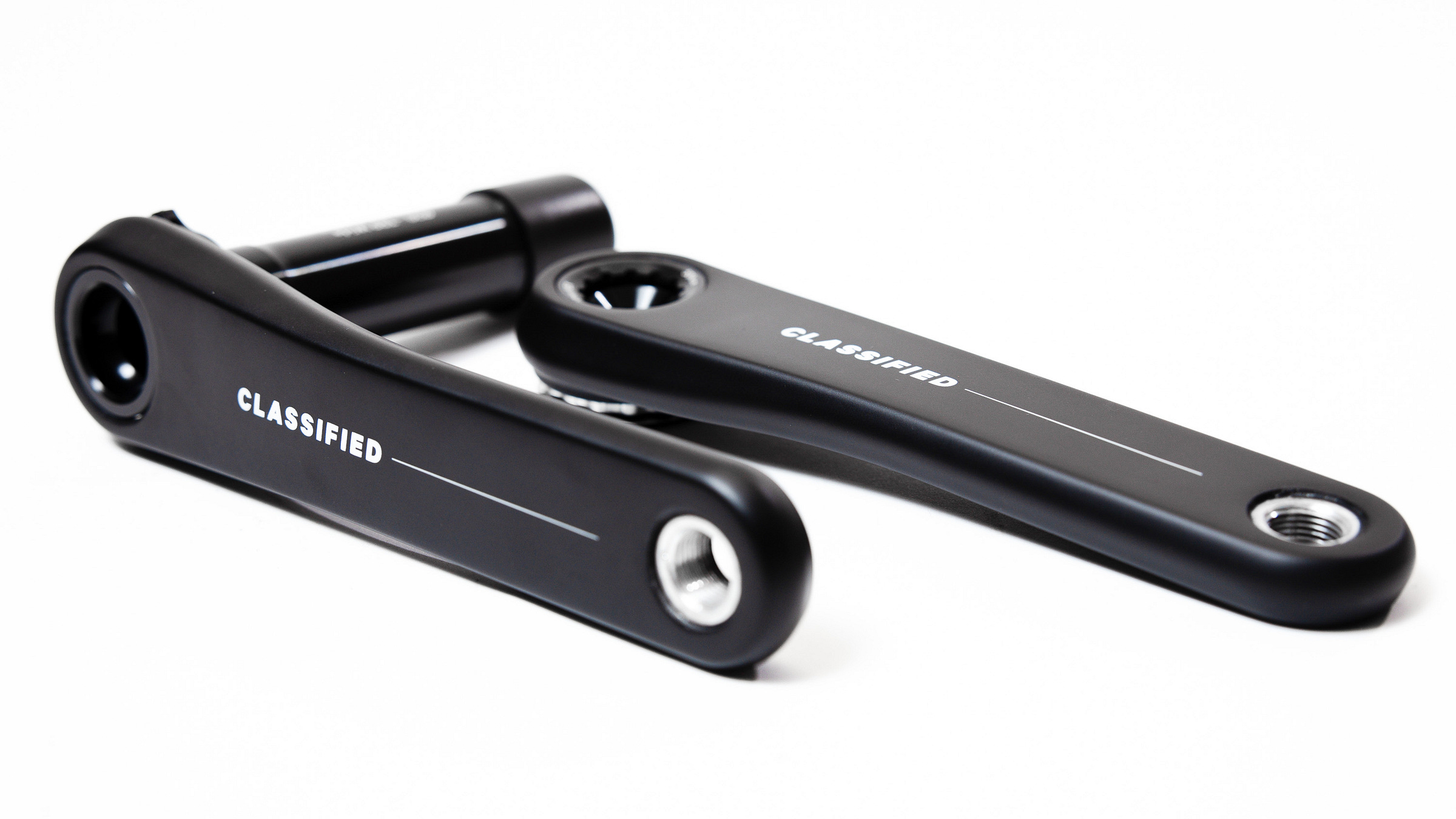
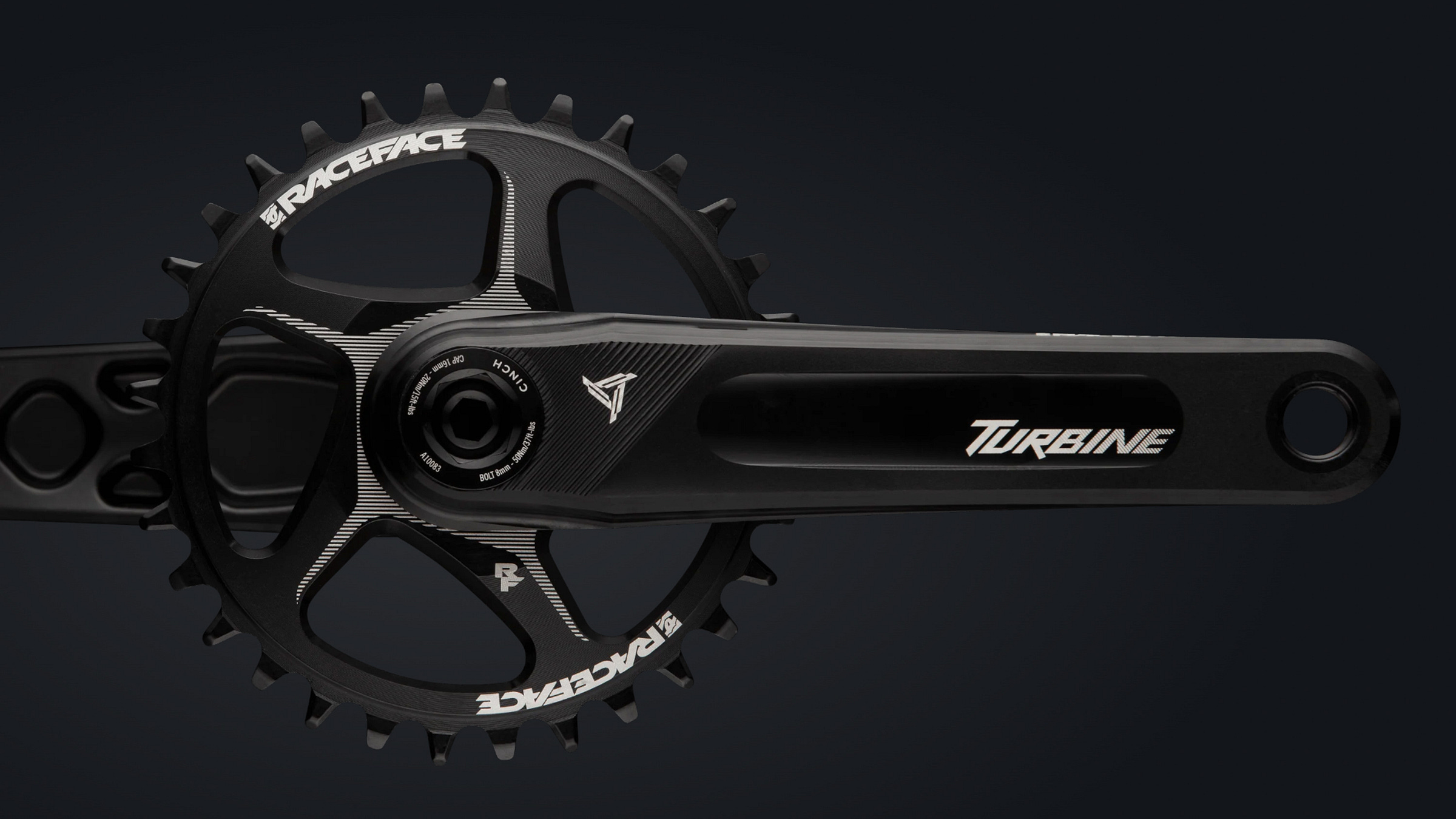
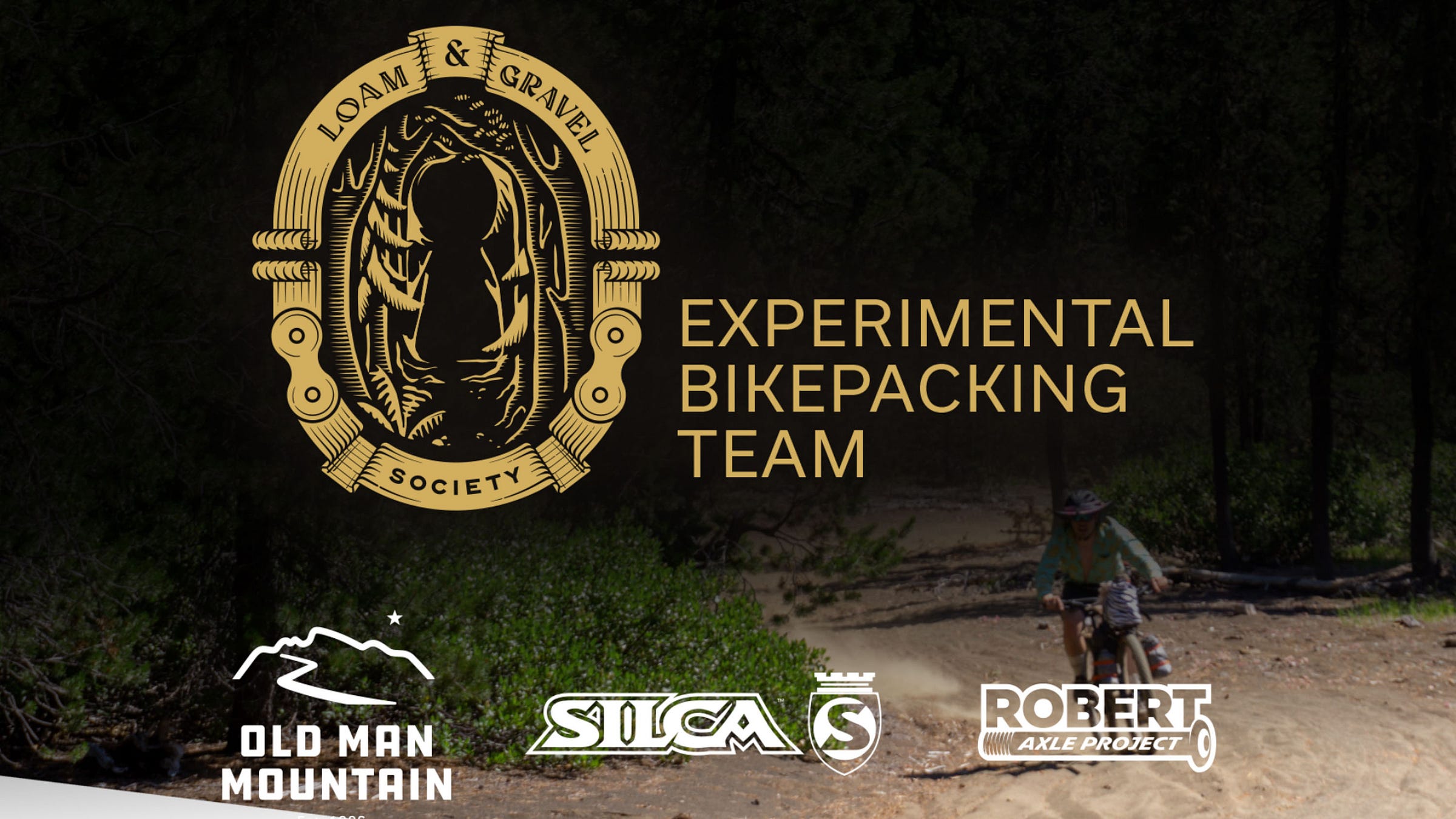
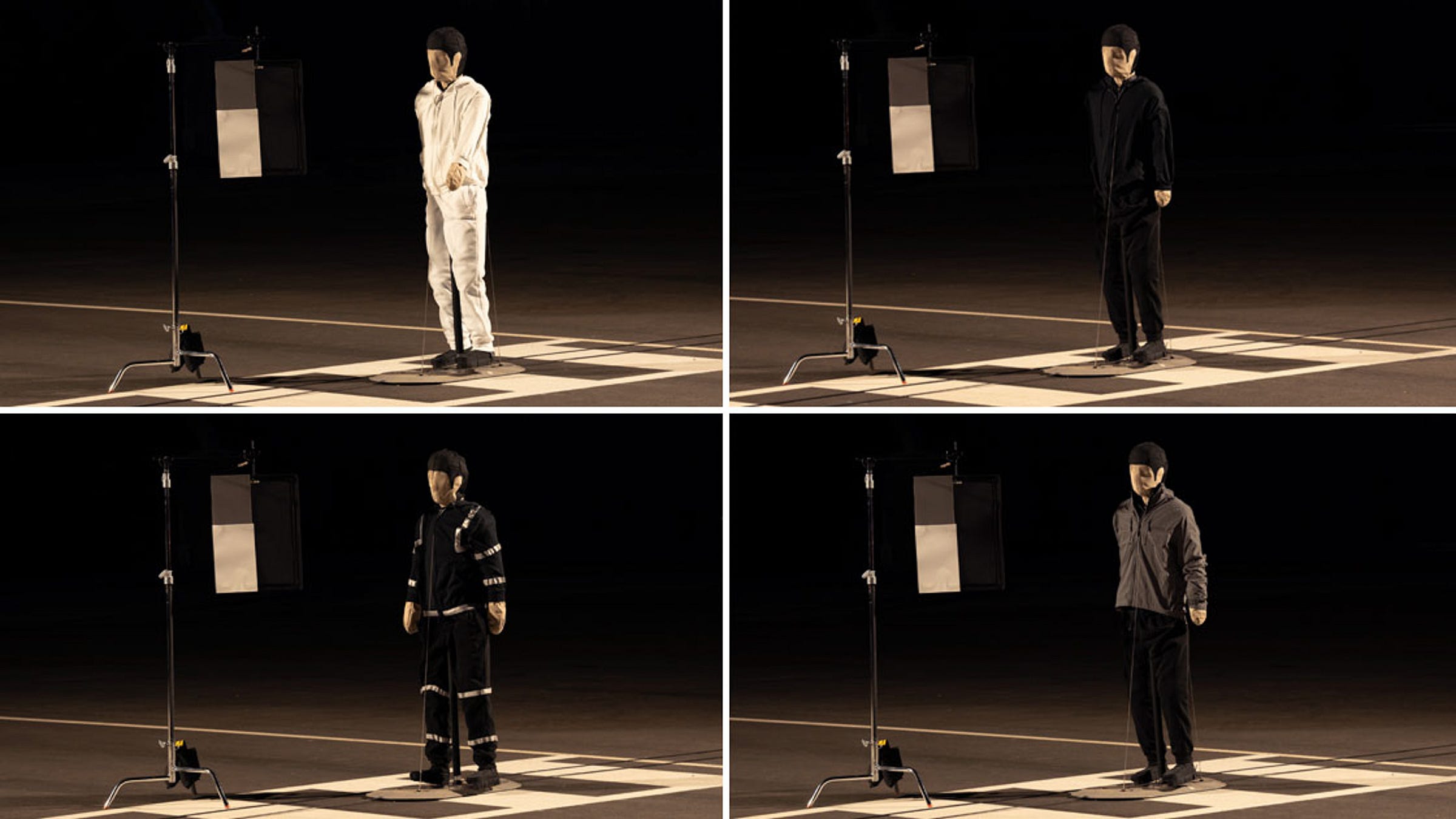
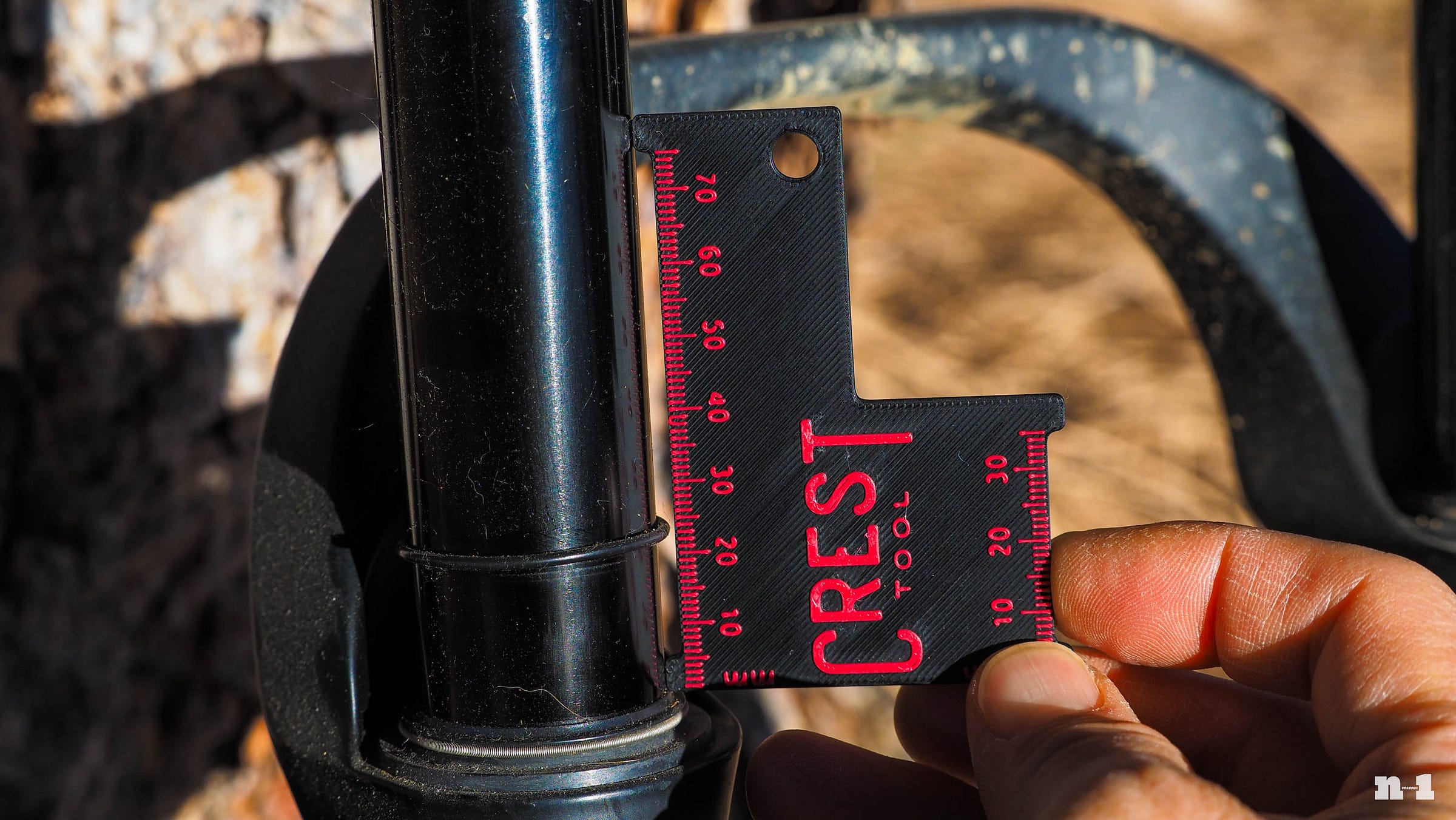
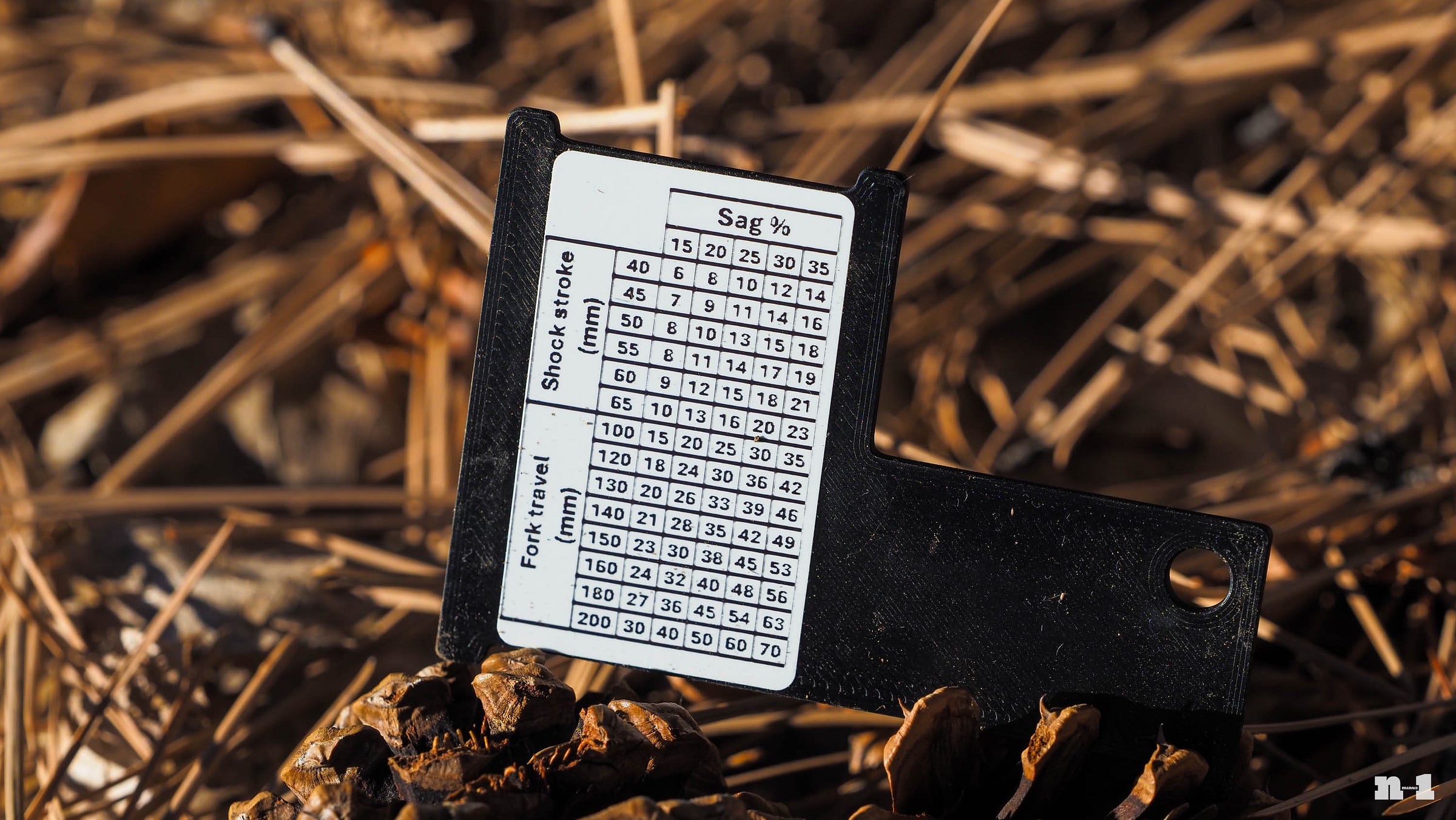
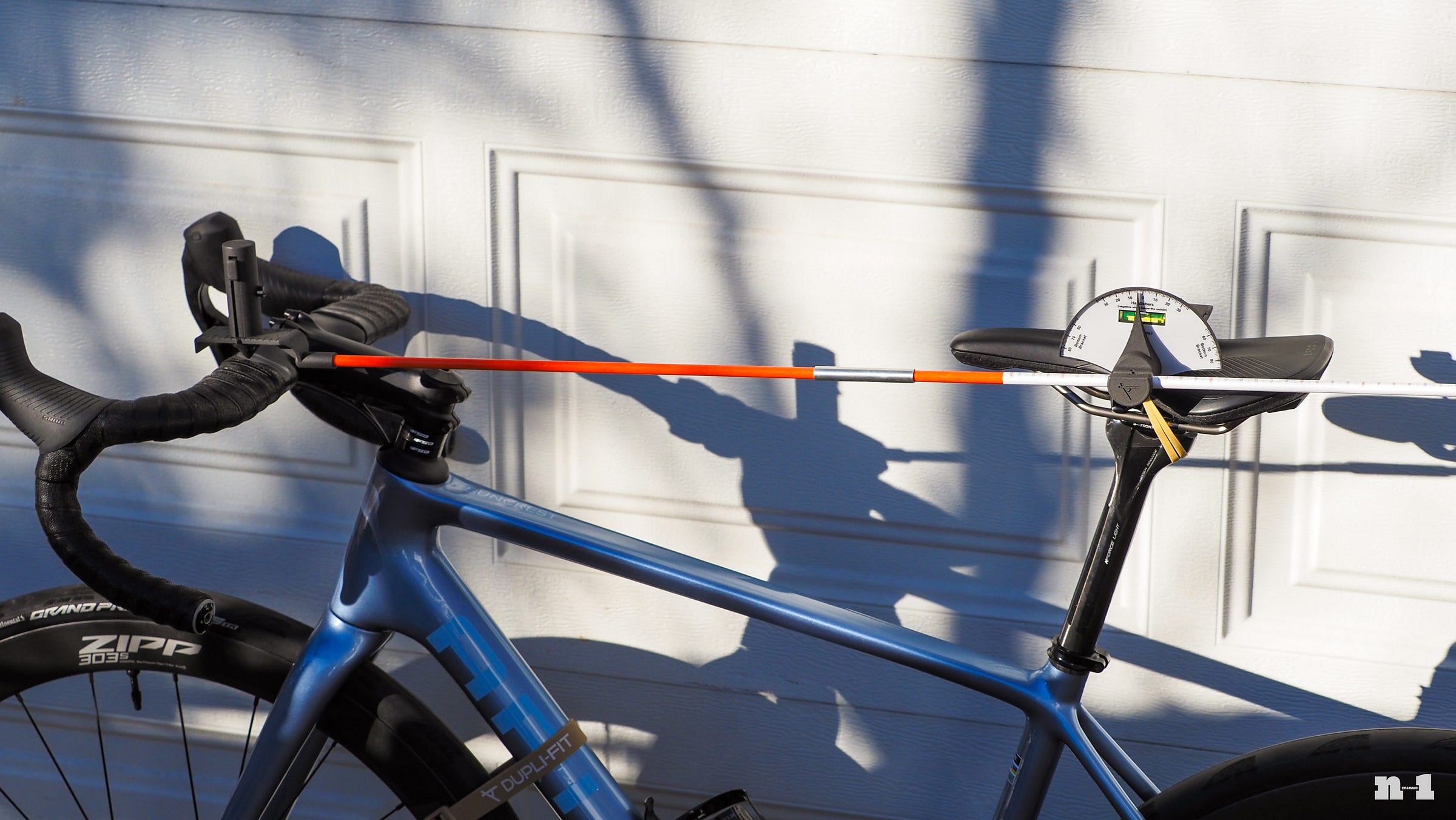

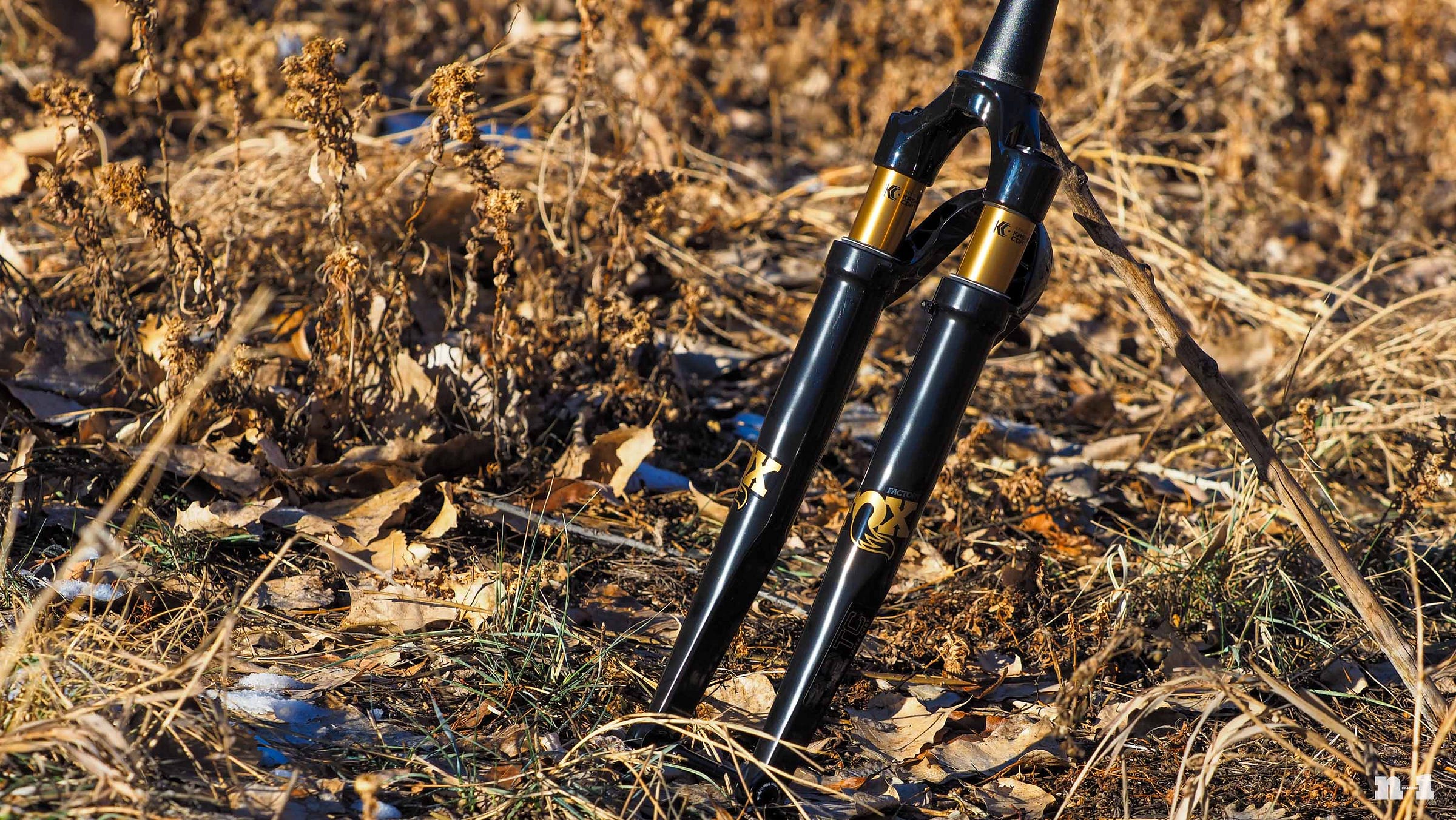
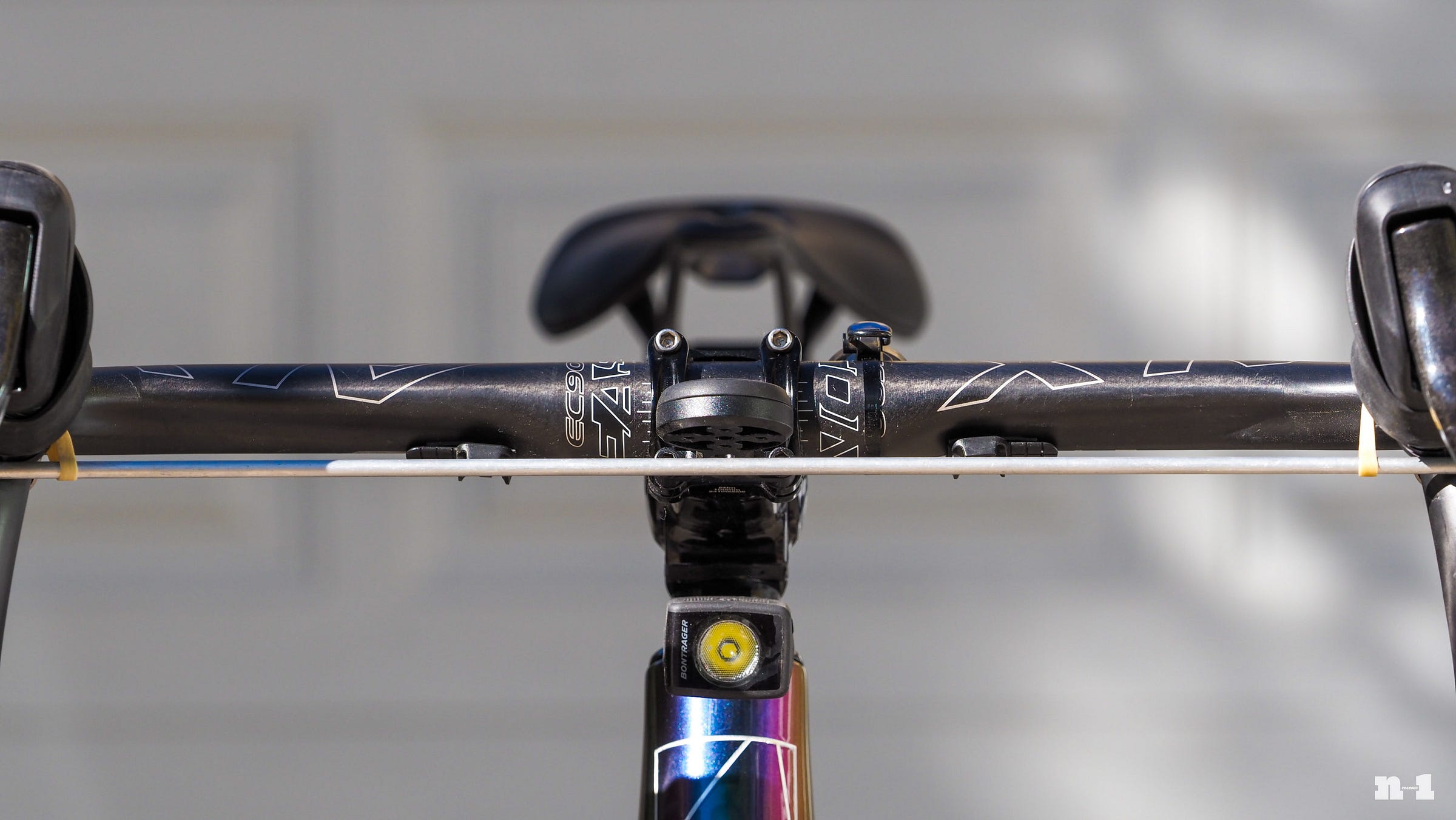

Hi James. What gives the formula caliper more power? Larger pistons? Pad compound? I would also be really interested in what the pad retraction is like and is there rubbing, etc.. This is because to get greater pad force due to bigger pistons the pad travel has to be reduced. Since the volume of fluid moved by the lever is the same as that added to the caliper and, if the pistons are bigger, then the travel has to be smaller to have the same fluid volume.
James, a request for your to-do list: an update for the Coros Dura now that they have had a chance to roll out software updates